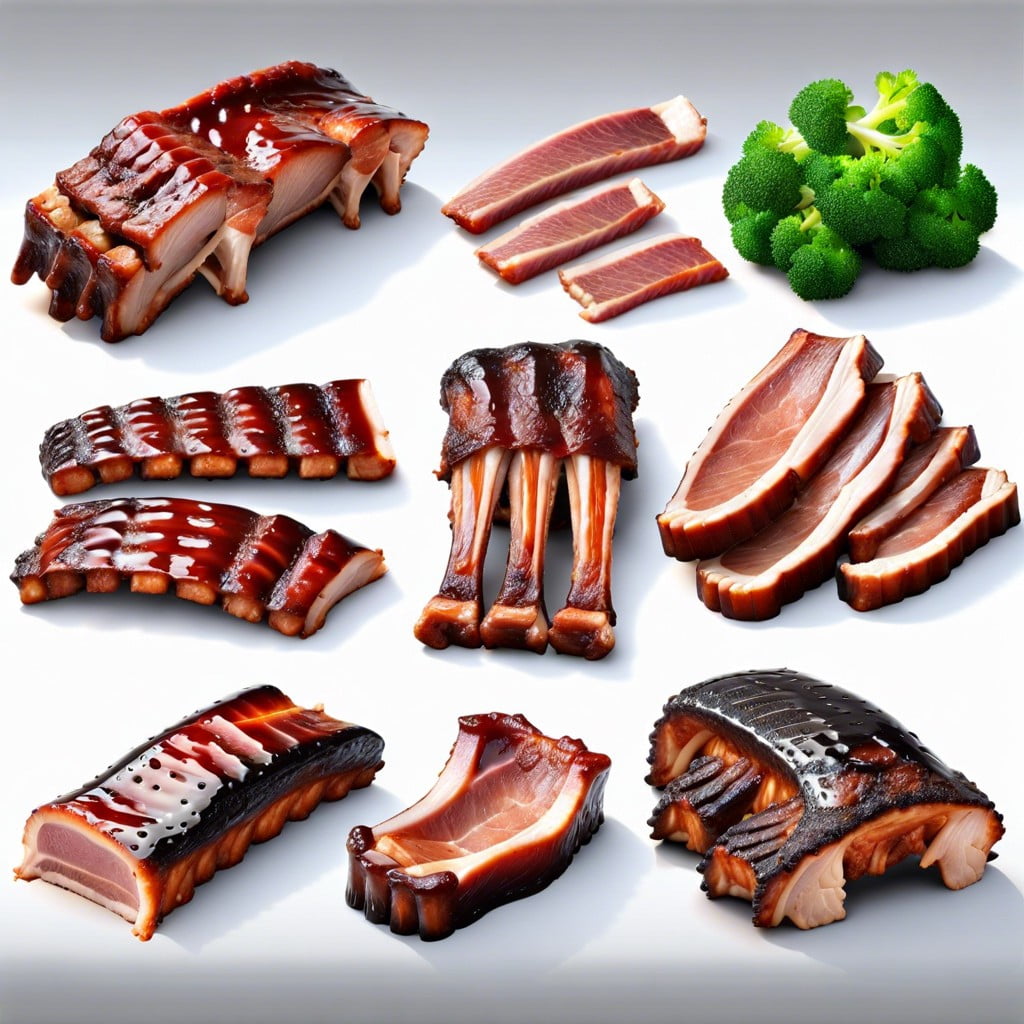Learn the essentials of oven-baking ribs for succulent, fall-off-the-bone tenderness that rivals traditional barbecued ribs.
Key takeaways:
- Choose the right cut of ribs for your desired outcome.
- Removing the membrane ensures tender, flavorful ribs.
- Preheat the oven to 275°F and tightly wrap the ribs in foil for tender results.
- Check for tenderness and optionally broil with barbecue sauce for a savory crust.
- Cooking ribs in the oven offers consistent heat and juicy results.
Which Cut of Ribs Is Best?

Choosing the best cut for oven-baked ribs depends on personal preference and the desired outcome. Baby back ribs, from the loin area, are leaner and cook faster, making them ideal for those who prefer a tender, less fatty result. Spare ribs, from the belly side, are meatier and fattier, requiring a longer cook time, but reward with rich flavor. For a middle ground, St. Louis-style ribs, trimmed from spare ribs, offer a balance between meatiness and manageability. The cut you select will determine the cooking time and the final texture of your ribs.
Why Should I Remove the Membrane From Ribs?
Removing the membrane, also known as silverskin, from a rack of ribs is a crucial step in preparation for several reasons. This thin, tough layer sits on the bone side of the ribs and can prevent seasonings and smoke from penetrating the meat effectively. Moreover, it creates a barrier that can result in uneven cooking and affect the final texture of the ribs.
When left on, the membrane can make the ribs chewier and less palatable. By peeling it off, you’re ensuring that the ribs will be tender, allowing for a better overall mouthfeel. It’s a simple task that can have a significant impact on the quality of your dish; just slide a knife under the membrane, lift, and peel it away with a paper towel for added grip.
Your efforts will be rewarded with rib meat that’s fully infused with flavors and the perfect bite-off-the-bone tenderness.
How to Cook Ribs in the Oven
Begin with preheating your oven to 275°F (135°C), a low temperature that allows the connective tissues in the ribs to break down over a few hours, rendering them perfectly tender. While the oven heats, season your ribs with a dry rub of choice or simply salt and pepper.
Next, tightly wrap the seasoned ribs in aluminum foil or use a covered baking dish to create a steamy environment that aids in the tenderization process. This method emulates a long, slow smoke session common in traditional barbecue cooking. The foil also captures any dripping juices, preventing dryness.
Place the ribs meat-side down on the middle rack of the preheated oven. The concept here is that the thicker, bony side will be closer to the heating element, ensuring even cooking. Cook for approximately 2.5 to 3 hours for baby back ribs or 3 to 3.5 hours for spare ribs.
After baking, check for tenderness – the meat should be just pulling away from the bone but not falling off, indicating it’s cooked through yet still juicy. Optionally, to emulate the caramelized exterior from grilling, remove the foil, coat the ribs with your favorite barbecue sauce, and broil for a few minutes until the sauce is bubbly and starting to char. This creates a savory crust contrasting with the moist, tender meat beneath.
Why This Recipe Works
Cooking ribs in the oven offers consistent low heat, which breaks down the tough proteins, tenderizing the meat without the unpredictability of outdoor elements impacting a grill or smoker. The enclosed oven environment also ensures the ribs retain moisture, creating a juicy result. Moreover, an oven provides the convenience of set-it-and-forget-it cooking, perfect for those without access to outdoor cooking spaces or during inclement weather, guaranteeing that savory BBQ flavors are achievable year-round.
Another advantage is the control over the cooking temperature, allowing for precise heat management which can be quite challenging on a grill or smoker, especially for less experienced cooks. The dry heat of the oven forms a delectable crust on the ribs as the sugars in the rub caramelize, which is often sought-after in traditional barbecuing techniques. Using the broiler function at the end of the cooking process can also mimic the direct heat of a grill to perfect that final sear and glaze. This method adapts well to various types of rib recipes, whether you favor saucy, dry-rubbed, sweet, or spicy variants.
What to Serve With Pork Ribs
Ideal accompaniments to pork ribs extend beyond the classic coleslaw. Consider balance and contrast when selecting side dishes. Acidic or tangy flavors cut through the richness of the meat, while textures that contrast the tenderness of slow-cooked ribs create a more satisfying eating experience.
– Fresh acidity can be introduced with a vinegary cucumber salad or a crisp apple slaw, which refreshes the palate between bites.
– For a textural counterpoint, offer roasted corn on the cob or garlic and herb charred broccolini. Their crispness juxtaposes the succulent texture of the ribs.
– Starchy sides like smoked Gouda mac and cheese or jalapeño cheddar cornbread soak up the ribs’ flavorful juices, making for a hearty meal.
– To elevate the dish with more sophistication, try a bright, peppery arugula salad tossed with a lemon vinaigrette or a side of roasted root vegetables seasoned with rosemary and thyme.
– For a touch of sweetness, grilled peaches or a corn and cherry tomato salad with a honey-balsamic dressing complement the smoky, savory flavor of the ribs.
Pairing these sides with pork ribs not only satisfies the appetite but also harmonizes with the bold flavors typically found in BBQ cuisine.

